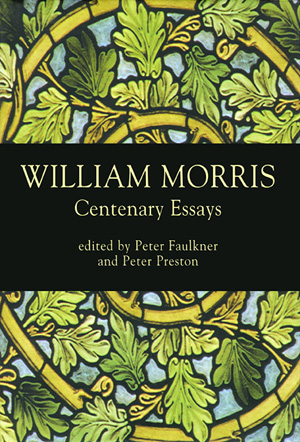 Don’t ask me how to discuss a book of essays on the life and work of a figure who was surely among the last Renaissance men. William Morris was a poet and polemicist, artist and designer, politician and businessman, and was tremendously influential on the way we think about the objects in our lives, and I am hard put to give any sort of adequate discussion of the essays contained in this discussion.
Don’t ask me how to discuss a book of essays on the life and work of a figure who was surely among the last Renaissance men. William Morris was a poet and polemicist, artist and designer, politician and businessman, and was tremendously influential on the way we think about the objects in our lives, and I am hard put to give any sort of adequate discussion of the essays contained in this discussion.
I can’t confess to more than a passing acquaintance with Morris, and so I endured all the pleasures and frustrations of a reader who can claim some knowledge but not a thorough knowledge of the subject. He was indeed a fascinating character, particularly, from my point of view, in his work as an author and designer. The Arts and Crafts movement was his, pure and simple, and as one reads through the essays in this collection, one realizes that his ideas on the subject grew from his heartfelt socialism, a movement for which he was one of the chief voices in England.
It becomes apparent that the central theme in Morris’ multivalent works was the idea of the dignity of labor, but not as a means of ennobling the assembly line, as became the object of so much Soviet realism. Morris espoused and practiced the idea that people should live surrounded by the products of their labor, and that manufacturing could be a collective effort in which each participant learned and practiced many skills. An intimate of the pre-Raphaelites — Dante Garbriel Rossetti and Edward and Georgiana Burne-Jones were among his closest friends — he shared their enthusiasm for a kind of idealized medievalism, a simpler life without the squalor. Sometimes almost a contrarian — in a time in which the classics of Greece and Rome were the measure of civilization, he turned to the Eddas and Das Nibelungenlied for his inspiration, as well as northern manuscript illuminations — Morris nevertheless exerted a profound influence on his contemporaries and successors.
The editors provide a substantial Introduction, giving a valuable overview of Morris’ career. This is followed by Florence S. Boos’ “An Aesthetic Ecocommunist: Morris the Red and Morris the Green,” a look at Morris as an environmentalist — a stance that grew out of his socialist philosophy and his belief in the value of access to nature in daily life. The entire second section of the book, “Morris in Literature,” is of great interest, discussing Morris’s versions of Das Niebelungenlied in “Sigurd the Volsung: Heroic Poetry in an Unheroic Age,” by Simon Dentith, followed by Amanda Hodgson’s “The Troy Connection: Myth and History in Sigurd the Volsung.” There are also two essays on News from Nowhere, Morris’ utopian novel that explicates his idea of the ideal socialist society. Morris was obviously an anti-statist; today we wouldn’t be too far off the mark in calling him a libertarian, although he displayed more compassion and less callousness than most libertarians I’ve run across: to Morris, the whole reason for society is mutual support.
Among the highlights of this collection is Ian J. Lochhead’s essay on transplanting Morris’ ideas to the architecture of New Zealand, “The Dilemma of Place: Arts and Crafts Architecture in the Antipodes,” which focuses on the career of S. Hurst Seager, who took Morris’ principles and Maori examples and developed a vocabulary at once relevant and beautiful. This third section of the book, “Morris, the Arts and Crafts and the New World,” also explores Morris’ influence in the United States, with explorations of Morris’ influence on architecture in Rhode Island and interior design in Boston.
The last section, “Morris, Gender and Politics,” pulls together many of the pieces from the earlier portions of the book, particularly in the realm of gender dichotomy (Morris was not the perfect egalitarian in those terms, as Ady Mineo notes in “Beyond the Law of the Father: The ‘New Woman” in News from Nowhere,” but he makes sense) and his influence on modern historians, particularly E. P. Thompson, author of the seminal and authoritative The Making of the English Working Class.
The centenary of Morris’ death in 1996 gave students a chance for a fresh evaluation of Morris’ life and career. Having had, as an art student, my nose shoved in the trough of art history, I did have some acquaintance with Morris, but after reading this collection, I’m convinced it wasn’t enough. There are in these essays the sort of insights that whet your appetite for more — my “to read” list, alas, has expanded again — and that kick your own thinking into high gear. So many of Morris’ ideas are so relevant to our present circumstances that one can only scratch one’s head and wonder why more people weren’t paying attention to begin with. We are spared, for the most part, the density of academic prose — the essays are readable by the nonspecialist, while they contain enough information to keep the student engaged — but the discourse around Morris’ work comes through very clearly.
If you don’t think you know enough about William Morris, I’m not completely sure I’d recommend this collection as an introduction. However, on reflection, I can think of a lot worse places to start.
(University of Exeter Press, 1999)
